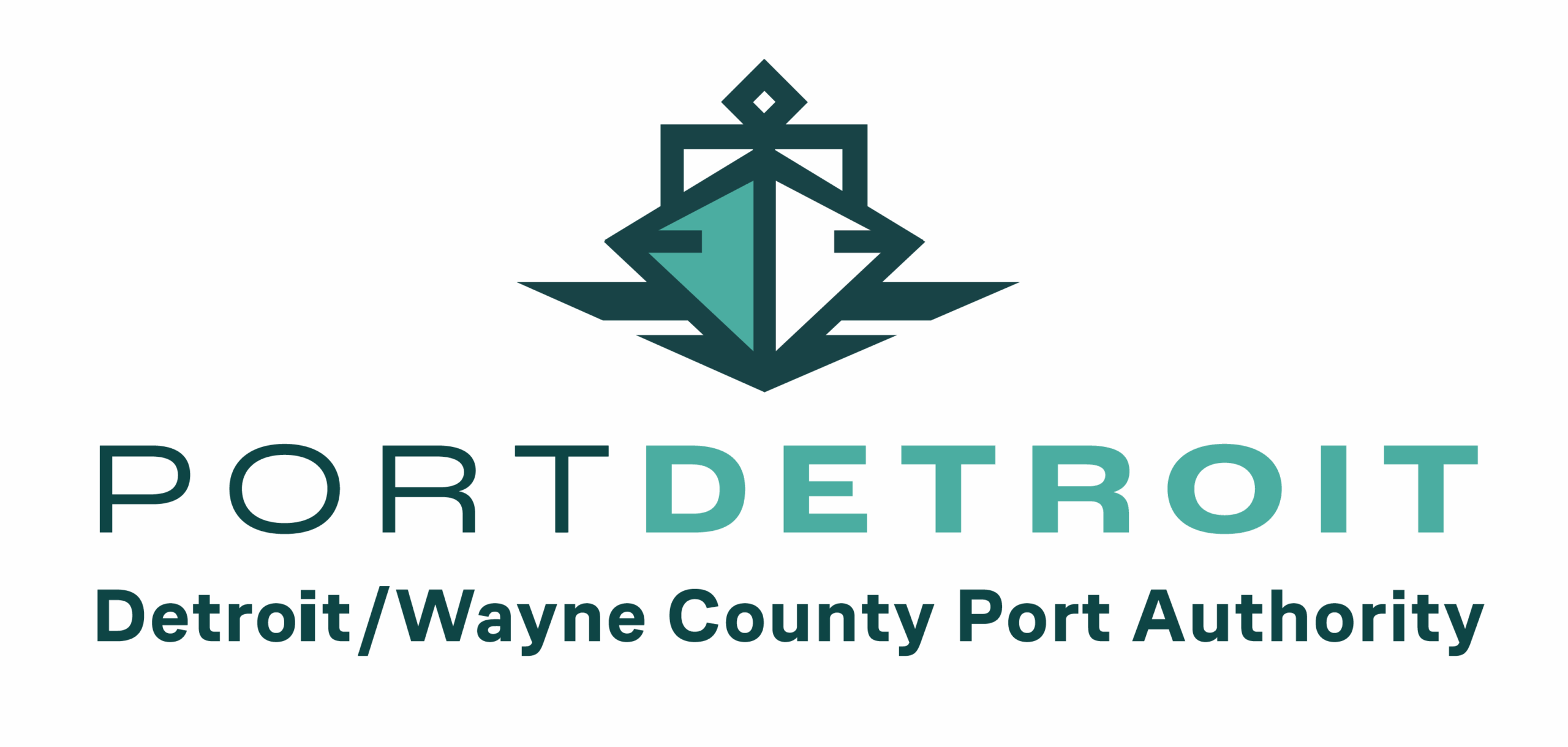History of Port Detroit
Port Detroit has a long and rich history, and has played a pivotal role in the formation of this great city. Learn about how the port of yesterday has shaped the port of today.
1701
The Founding of Detroit
French explorer and adventurer Antoine de la Mothe Cadillac founded Detroit in 1701, planting the flag of France at what is now Griswold Street. His settlement secured the critical geography between the upper and lower Great Lakes, setting the stage for Detroit’s strategic maritime importance.
1751
Petit Cote and Early Growth
By 1751, the area was known as Petit Cote (“Little Coast”). The port played a pivotal role in Detroit’s early development and helped shape the city’s future. As Detroit expanded during the 19th century with U.S. settlement around the Great Lakes, the port became central to its industrial rise. By 1920, driven by the auto industry and immigration, Detroit had grown into a world-class industrial powerhouse and the fourth-largest city in the United States. With this growth, the Port of Detroit became Michigan’s largest seaport. Today, the port remains home to centuries-old artifacts that tell the story of the city’s maritime heritage.
1925
The Port Districts Act
The Michigan Legislature passed Public Act 234, the Port Districts Act, calling for the creation of Port Districts to coordinate maritime trade and strengthen regional commerce.
1933
Detroit/Wayne County Port District Established
The Detroit/Wayne County Port District was established, granting jurisdiction over the waterways and shoreline of Wayne County. This formalized Detroit’s role as a key hub for shipping and trade on the Great Lakes.
1978
Port Authority Organized
Although the Port District had existed for decades, the Detroit/Wayne County Port Authority was formally organized in 1978 to oversee port operations, promote economic development, and serve as a steward for the region’s maritime assets.
1980
October 10th — First Port Authority Board Meeting
The Port Authority held its inaugural board meeting, selecting Henry Ford II as its first chairman, marking the start of a new era of leadership on Detroit’s waterfront.
1999
Building a New Terminal
The Port Authority secured $7.1 million in federal stimulus funding, championed by U.S. Senator Carl Levin, to build an offshore wharf and passenger ship terminal. This project revitalized the waterfront and provided infrastructure to serve cruise ships, tall ships, and government vessels.
2011
Opening of the Carl M. Levin Public Dock & Terminal
With great public fanfare, the new terminal and dock officially opened, restoring Detroit’s historic downtown riverfront as a destination for cruise ships and passenger vessels — the same site used by cruise ships since 1909.
Modern Day
A Thriving Maritime Gateway
Today, the terminal has hosted over 100 cruise ships and excursion vessels, helping to generate more than $20 million in local economic impact through tourism tied to attractions like The Henry Ford and the Motown Museum. The Detroit/Wayne County Port Authority also owns the city’s largest freight terminal and promotes the region’s private terminals, continuing its legacy of economic growth and maritime leadership.
Net Zero by 2040
The Port Authority has expanded its mission to include a port-wide decarbonization program aimed at achieving net zero by 2040. Through this ambitious initiative, the port has secured federal and state grants to support clean energy technologies and infrastructure upgrades, helping to ensure a sustainable future.
Cruising Through History
From 1920 through 1967, Detroit had a vibrant cruise ship industry with many different cruise ship lines docking on the very site that the new Detroit Wayne Count Port Authority Public Dock and Terminal building sits today.
Artifacts on Display
Port Detroit has a long and storied history and is the current home to some centuries old artifacts that tell the story of this great city.

Story of the Cannon
18th Century British Cannon Barrel
Brought to Detroit by British troops after Pontiac’s Uprising in 1763, this “4 Pounder” cannon was on of the smaller pieces of artillery at Fort Detroit. The name indicates that id fired a four pound ball. Research indicates that the British commander ordered this cannon, along with several others, dumped in the Detroit River to dispose of them prior to turning the fort over to the Americans in 1776.
Forged in England in the mid- 1700s, this cast iron barrel bears the crest of King George II (1727-1760), as well as several markings “11 -1-4” indicating the weight of the cannon, 1,264 pounds.
In 1987, a group of divers from the Detroit Police Department Underwater Recovery Team and the Dossin Great Lakes Museum found this cannon and recovered it. To date, six barrels have been salvaged, the most recent surfacing in October 2011. All were found in close proximity to each other about two hundred feet from the riverwalk adjacent to Huntington Place, formerly known as Cobo Hall.
Displayed at the Port Authority Facility, near where it rested underwater for two centuries, this cannon reminds us that our boarder was not always as peaceful and friendly as it has been since the War of 1812.
This cannon is on loan courtesy of the Detroit Historical Society.

The Anchor Story
Detroit & Cleveland Steam Navigation Company 1850-1950
For a century the D&C line provided overnight passenger and freight service across Lake Eire between Detroit, Michigan and Cleveland Ohio. The D&C fleet was incorporated in 1868, and by 1909 provided overnight and vacation cruise service to the major ports on Lake Eire, Lake Huron, and Lake Michigan. As the vessels of the company ages and traffic increased, newer side-wheeled vessels joined the fleet.
In 1922 the naval architect Frank E. Kirby provided the Detroit and Cleveland Steam Navigation Company with architectural drawings for two massive side-wheeled sister ships that would carry passengers and freight on the Buffalo to Detroit route. Two vessels, the S.S. Greater Detroit and the S.S. Greater Buffalo would provide continual service across lake Eire. The overall length of the vessels would be 536 feet and with the side paddle wheels the overall width was to be 96 feet.
The contract to construct these new additions to the fleet was given to the American Ship Building Company in Lorain, Ohio. The hull of the S.S. Greater Detroit was launched on September 15,1923 and then towed to Detroit where the shipyard carpenters, painters, decorators, mechanics, and artists completed the upper wooden decks of the vessel. It took almost a year to complete the vessel and the S.S. Greater Detroit entered service on August 29, 1924. The overnight boat could carry some 2,127 passengers and provide accommodations with 625 staterooms and could store 103 automobiles on the main deck.
The Detroit & Cleveland Navigation Company lasted through the 1950 season, and on May 9, 1951 the company announced the suspension of service on the great lakes. The vessels were eventually sold off or scrapped. The S.S. Greater Detroit was towed out to be burned on Lake Ste. Clair in December 1956.
This bow anchor from the S.S. Greater Detroit was cut in December 1956 and abandoned on the bottom of the Detroit River. Captain William A. Hoey notified the Great Lakes Maritime Institute’s Dive Team that he watched as the anchor chain was cut since there was no live steam available on the vessel to raise the anchor.
The Great Lakes Maritime Institute’s Dive Team searched for this 6000 pound artifact, and finally located is some 200 feet out in the Detroit River. The anchor was recovered November 15, 2016 with the assistance of the J.W. Westcott Company, the International Shipmasters Association and the Durocher Marine Division of Kokosing Industrial. The cleaned, primed and painted anchor is now on display in front of the Detroit/Wayne County Port Authority.

